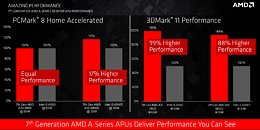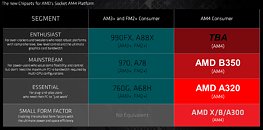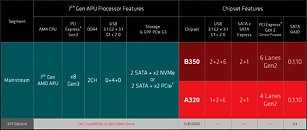Monday, September 5th 2016

AMD Unveils its 7th Generation A-Series Desktop APUs
AMD today unveiled its 7th generation A-series desktop APUs. Unlike its predecessors, the new chips are full-fledged SoCs, built in the new socket AM4 package, on which the company plans to launch its "Zen" processors. The 7th gen A-series APUs are based on the "Bristol Ridge" silicon, and are the first fully-integrated SoCs (systems-on-chip) from the company in the performance-desktop segment, in that the APU completely integrates the functionality of a motherboard chipset, including its FCH or southbridge.
This level of integration includes PCI-Express root-complex, USB 3.0, and storage interfaces such as SATA 6 Gb/s emerging directly from the AM4 socket. Some AM4 motherboards could still include a sort of "chipset," which expands connectivity options, such as USB 3.1 ports, additional SATA ports, and a few more downstream PCI-Express lanes. The amount of downstream connectivity and features decide the grade of the chipset. AMD is initially launching two chipsets, the A320 for the entry-level segment, and the B350 for mainstream desktops. The company plans to launch an even more feature-rich chipset at a later date (probably alongside ZEN "Summit Ridge" CPUs).The 7th generation "Bristol Ridge" A-series desktop APUs aren't a launch platform for ZEN. These chips feature up to four CPU cores based on the "Excavator" architecture, AMD's final implementation of the modular CPU architecture it introduced with "Bulldozer," way back in 2011. These cores are mated with an integrated GPU based on the Graphics CoreNext 1.2 architecture. You get up to 8 GCN compute units, working out to up to 512 stream processors.AMD is launching eight SKUs in the series, of which six are quad-core, two dual-core. The quad-core parts with 8 GCN compute units are pitted into the A12-9800 series; quad-core parts with 6 GCN compute units as A10-9700 series, and quad-core with 6 GCN CUs and lower iGPU clock bands as A8-9600 series. The dual-core parts with 6 or 4 GCN CUs are slotted in the A6-9500 series. Parts with quad-core CPU but completely lacking in integrated graphics, are slotted in the Athlon X4 series.
This level of integration includes PCI-Express root-complex, USB 3.0, and storage interfaces such as SATA 6 Gb/s emerging directly from the AM4 socket. Some AM4 motherboards could still include a sort of "chipset," which expands connectivity options, such as USB 3.1 ports, additional SATA ports, and a few more downstream PCI-Express lanes. The amount of downstream connectivity and features decide the grade of the chipset. AMD is initially launching two chipsets, the A320 for the entry-level segment, and the B350 for mainstream desktops. The company plans to launch an even more feature-rich chipset at a later date (probably alongside ZEN "Summit Ridge" CPUs).The 7th generation "Bristol Ridge" A-series desktop APUs aren't a launch platform for ZEN. These chips feature up to four CPU cores based on the "Excavator" architecture, AMD's final implementation of the modular CPU architecture it introduced with "Bulldozer," way back in 2011. These cores are mated with an integrated GPU based on the Graphics CoreNext 1.2 architecture. You get up to 8 GCN compute units, working out to up to 512 stream processors.AMD is launching eight SKUs in the series, of which six are quad-core, two dual-core. The quad-core parts with 8 GCN compute units are pitted into the A12-9800 series; quad-core parts with 6 GCN compute units as A10-9700 series, and quad-core with 6 GCN CUs and lower iGPU clock bands as A8-9600 series. The dual-core parts with 6 or 4 GCN CUs are slotted in the A6-9500 series. Parts with quad-core CPU but completely lacking in integrated graphics, are slotted in the Athlon X4 series.





45 Comments on AMD Unveils its 7th Generation A-Series Desktop APUs
Any launch timeframe?
A = AMD Z = Zen ## = platform level would make more sense
AZ 940
AZ 840
AZ 740
AMD Zen 9 high perform 4 Am4 socket 0 revision would have made more sense and would have fit in with the current GPU naming scheme.
[Removed comment as I was incorrect.]
The word on the "street" is that Asmedia made the "chipsets" for AMD, so the USB 3.0 should at least be better than AMD's past attempts...
These people really like to shoot themselves.